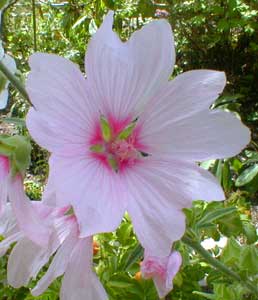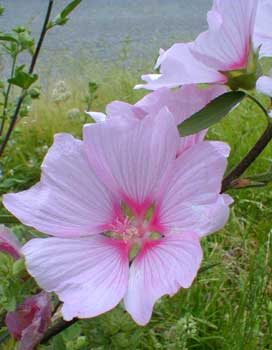
Barnsley Bush Mallow
"Cold, delicately as the dark snow
A fox's nose touches twig, leaf;
Two eyes serve a movement, that now
And again now, & now, & now."
-Ted Hughes
(1930-1998)
(1930-1998)
'Barnsley' tree mallow, bush mallow, or gaymallow, has large three or four inch light pink flowers that start out almost white, & having a dark red-pink eye.
It is very impressively in full bloom in our garden by mid-May (when the second photo was snapped), even more thickly flowered in June, with continuous rebloom well into autumn.
In more northerly gardens or in a location without sunlight both morning & afternoon it is apt to wait until June or July to kick into action, then flower without interuption until the first hard frost stops it.
 It is what is known as a "periclinal chimaera" of the cultivar 'Rosea' & is not entirely stable. It can revert to 'Rosea,' which fortunately is still an outstanding shrub. 'Barnsley' is a partially albino form of 'Rosea,' the main difference being that 'Rosea' blooms are overall pink, with faded eye.
It is what is known as a "periclinal chimaera" of the cultivar 'Rosea' & is not entirely stable. It can revert to 'Rosea,' which fortunately is still an outstanding shrub. 'Barnsley' is a partially albino form of 'Rosea,' the main difference being that 'Rosea' blooms are overall pink, with faded eye.To lessen the possibility of a reversion, 'Barnsley' should never be pruned back quite so far as one would be apt to prune other tree mallows. This can be a balancing act, because it requires a generous spring pruning, since it blooms on new wood, plus it can look lanky with poor leafage on the old lower portions, if even one year of pruning is skipped.
Where a more stable variety would be cut back to a foot height in spring before new growth begins, 'Barnsley' should only be cut to between two & three feet or risk reversion to 'Rosea.' Some recommend pinching it back later in spring just before it begins blooming, rather than hard-pruning in early spring. Such a late prune will mean fewer flowers, but larger ones, & still numerous enough.
Lavatera clementii cultivars are actually hybrids of L. olbia & L. thuringiaca. They are for the most part sterile hybrids. The hybrids are hardier than L. olbia, but not quite as hardy as L. thuringiaca. They usually have a growth habit more closely resembling L. thuringiaca, but less upright with more a rounded "starburst" arrangement to its many limbs, & smaller overall size, though it's still a big shrub.
 'Barnsley' is not hardy in areas with really cold winters, but it is hardy indeed in our temperate zone. It keeps its leaves so long into Puget Sound winters that it can seem like a semi-evergreen. Growth rate is so rapid that it is sometimes grown as an effective annual down to zone 4 or 5, but to perennialize & develop into a healthy shrub, zones 7 to 9 are practical.
'Barnsley' is not hardy in areas with really cold winters, but it is hardy indeed in our temperate zone. It keeps its leaves so long into Puget Sound winters that it can seem like a semi-evergreen. Growth rate is so rapid that it is sometimes grown as an effective annual down to zone 4 or 5, but to perennialize & develop into a healthy shrub, zones 7 to 9 are practical.Once established it is very drought hardy. It wants the fullest sun in a xeriscape garden, with sharply draining soil. It conceivably can reach nine feet of height with six foot fountaining spread, but may be lanky & less pleasing if allowed to go so large, & will look better kept in the four to six foot range.
Ours grows in a xeriscape garden on the street, where we let it spring up to a full seven foot flowery fountain amidst other shrubs. It was a delightful shrub its first year. By its second year it was already well enough rooted to produce vigorous branches full of larger than average hollyhock-like blooms.
Unfortunately it was so large it blocked the nearby intersection view from the stop sign. The city sent me a notice to move it or cut it down. This is not a shrub that likes to be transplanted, as the root system is very large & gets chopped all to hell digging it up. I gave it a try anyway, pruning it to two-feet before the painfully difficult transplant. The brittle roots were slow in recovery & it was not such a perfect shrub the following summer, but by its second summer in the new location, it was once again a beauty.
A piece of the root left behind in the former location sprang up to form another shrub closer to 'Rosea' in appearance. That, too, had to be dug out of course. I put it in a large pot & don't intend to keep it, as I've not room for two such big mallows.
The cultivar name is after the gardens of Barnsley House in the village of Barnsley in the Cotswold, Gloucestershire, England, where it was first grown by Rosemary Verey (1919-2001), author of such books as The Garden in Winter, The Scented Garden, & Rosemary Verey's Making of a Garden.
The genus is named for Johann Kaspar Lavater (1741-1801), whose portrait is on this page. This 16th Century Swiss naturalist, theologian, & poet believed in the crackpot science of physiognomy, which is the belief that all things about an individual can be deduced by the nature of his or her facial features. He seems otherwise to have been quite a decent & intelligent chap.
Being one of the longest-flowering performers in our own garden, I decided to plant bush mallows in the garden of friends for whom I do some landscaping. As this was a very extensive series of gardens I planted three varieties, not only 'Barnsley' but other clementii hybrids 'Bredon Spring' & 'Red Rum.'